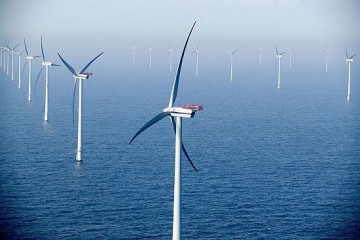Offshore Wind Farms Reduce Value of Recreational Boating Experience, Says New Survey
Monday, February 01, 2021
A survey of recreational boaters conducted by a team of University of Rhode Island researchers found that offshore wind farms detract significantly from the boating experience.
The study is released as wind projects are being promoted by Governor Gina Raimondo’s administration.
Tracey Dalton, the URI professor of marine affairs who led the survey, said that while most respondents indicated that seeing offshore wind turbines far in the distance did not affect their experience, most preferred not to go boating close to the turbines.
GET THE LATEST BREAKING NEWS HERE -- SIGN UP FOR GOLOCAL FREE DAILY EBLASTMore than 680 boaters with a hailing port in Rhode Island completed surveys in 2018. All owned Coast Guard-certified boats, meaning their vessels were at least 26-feet long. The research was published in December in the journal Marine Policy.
“There have been a lot of studies looking at the ecological impacts of offshore wind farms, but we’re interested in what happens when you put a new structure in place in the ocean and how it impacts people that have historically and culturally used that space,” Dalton said.
On Monday, Ørsted -- who acquired Deepwater Wind in Rhode Island -- responded to the findings.
“In its four years of operations, we’ve seen the area in and around the Block Island Wind Farm remain a popular location for mariners of all types, including members of the recreational fishing and boating communities. America’s first offshore wind farm is a model for how wind farms can coexist with other ocean activities," said Meaghan Wims, spokesperson for Ørsted.
Fishing -- And Other Factors
According to Dalton, those whose boating objective was fishing were less negatively affected by the turbines, perhaps because the turbine structures have been shown to attract sport fish.
Non-fishermen and those who had never been close to the Block Island wind farm before indicated their experience was most negative.
“We don’t really know why they reacted that way,” Dalton said. “It could be because of navigational concerns or concerns about other boaters being nearby, since the structures attract other users and it can get crowded out there.
“The Block Island wind farm is relatively close to shore,” Dalton said. “Most wind farms that have been proposed along the East Coast are going to be much farther offshore, so it’s not clear if we’ll see the same issues for those that we see here.”
About 1.7 million acres off the East Coast are being considered for offshore wind development in the coming decade, so the results of the URI survey could have significant implications.
“As we think about where we’re going to put wind farms, we have to be careful because we’re going to displace users,” said Dalton. “In this case, the boaters don’t mind being far from turbines, so as long as there’s not a wall of turbines stretched across the ocean, they can move away from them. But managers should be aware of the heterogeneity within the boating population. Fishermen feel differently than those not fishing; those who’ve been to the Block Island wind farm seem to feel differently than those who haven’t. The more people visit a wind farm, the more comfortable they might be around them.”
“I’m also interested in the social carrying capacity of offshore wind farms,” Dalton said. “Boaters don’t want to be in places where there are a lot of other boaters, so one study I want to pursue is looking at how levels of use at wind farm sites are impacting users. Are they attracting so many users that it’s turning others away?”
This study was funded by taxpayer funded via the Rhode Island Sea Grant program.
Updated Monday 1:48 PM
Related Articles
- Grybowski, CEO of Deepwater, Who Launched America’s 1st Offshore Wind Farm, Steps Down
- RI Public Utilities Commission Approves Revolution Wind Power Contract
- RI Lands Wind Company’s U.S. Headquarters, Bolsters Growing Renewable Industry
- VIDEO: Offshore Wind Company Ørsted Officially Opens Innovation Hub in Providence at Wexford
- High Wind Warning Issued for RI Starting Monday Afternoon - Power Outages Possible
- Whitcomb: Done Deal Via Minority Rule; Repulsive Roadblock; Offshore Wind Power Deficit; Leave Leave



